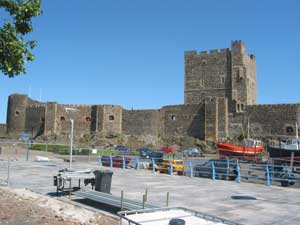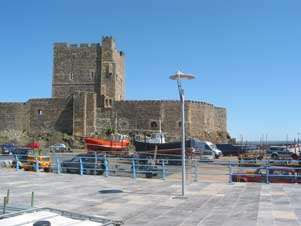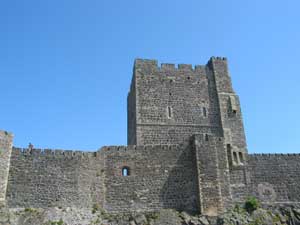Being our last day in Ireland and having some time to kill before the sailing, some of us decided to take a wee detour via Derry and Carrickfergus before heading for the ferry terminal in Larne. The day started with getting the car jump started, its not that it the car is old and failing or anything like that, the battery was drained expectedly!!! when we used the cd player for our sound system the night before.
Anyway leaving Letterkenny we thought we would pass through Derry to see the historic walls. We didn’t actually stop in Derry as our aim was visit Carrickfergus instead, it was kind of decided that it would need more time to find places in Derry which were worth looking at, so with a bit of fact finding perhaps it could be part of another trip in the future.
Arriving in Carrickfergus we decided to eat and we came across a nice resturant which was shadowed by the Castle and over looking a marina, in fact with the brilliant blue skies above you could have, that day, mistaken Carrickfergus for somewhere in the south of France. Enjoying our lunch out doors we were entertained from a distance by a local piper playing in the nearby castle, what more could you ask for!!!!
Walking round the castle and reading the information boards I expected to see something which related to the Bruce’s , but was a bit let down as there was nothing at all, which I didn’t expect as Edward Bruce laid siege to the castle in 1316 and was well renowned in the area.
Leaving the castle we had few words with the piper and one of the management. The piper told us he was there to play for a wedding party and not hired by the castle, as we had thought. To show how much a small world we actually live in he told us that he had been in Dumbarton for the piping championships a couple of weeks earlier. The manager was also telling us that Carrickfergus Castle as a tourist attraction is not all that well attended, but has picked up some what since the troubles in the area had retracted or visibly disappeared, hopefully this can continue as it is a shame that such a historic building should be neglected as such.
Carrickfergus (from the Irish: Carraig Fhearghais meaning "Rock of Fergus") is a large town in County Antrim, Northern Ireland.
Carrickfergus was a key to the Anglo-Norman hold on Ulster and stands on the north shore of Belfast Lough and is home to the 12th century Carrickfergus Castle. The Castle, one of the best-preserved Norman castles in Ireland. It was built around 1180 by John de Courcy, conqueror of Ulster, between about 1180 and his fall in 1204. It was captured by King John after a siege in 1210, and the Middle Ward may date from after that event. The Outer Ward was probably added during Hugh de Lacy's lordship, between 1228 and 1242. During the Edward Bruce invasion the English retreated to Carrickfergus after the battle of Connor, and the castle fell to the Scots in September 1316, after a year's siege. It remained an important residential and administrative centre in the later middle ages but was not involved in warfare. Renewed building activity dates from the 16th century, when alterations were made for defence by and against artillery, but its importance declined and the castle was in disrepair when Schomberg took it for William III in 1690. It was last captured in 1760 by the French commander, Thurot, after a heroic defence by the garrison. After its use as a prison in the 18th century it was further strengthened and served as a magazine and armoury until 1928, whilst the Keep was used as an air-raid shelter in the 1939-45 war. This long and complex history is reflected in the extensive structures which remain.
Carrickfergus Castle is a self-guiding facility. Information boards around the Castle & audio visual displays allow you to explore this historic monument at your leisure whilst getting an insight into the history of the Castle. As you walk around the Castle you will find historic figures that bring its stormy history to life. From the Norman knight, John de Courcy and his wife Lady Affreca to guards at their posts keeping watch over the Castle, these life size models portray the characters that make up the Castle's history.
The Battle of Carrickfergus, part of the Nine Years War, took place in and around the town in November 1597. It was fought between the crown forces of Queen Elizabeth I and the Scots clan of MacDonnell, and resulted in a defeat for the English.
The decaying castle withstood several days of siege by the forces of William of Orange in 1689, before surrendering on 28 August; William himself subsequently landed at Carrickfergus on 14 June 1690.
By Jim Singer |






